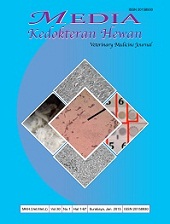Systemic Anti-inflammatory Activity of American Cockroach (Periplaneta americana) Extract: A Molecular Docking Study
Downloads
Surgery can trigger systemic inflammatory response syndrome. This study aims to determine the effectiveness of Periplaneta americana cockroach extract as an oral systemic anti-inflammatory agent using molecular docking. The molecular docking method consisted of five steps. The first step was preparing the TNF-α converting enzyme (TACE) receptor as a native ligand, dexamethasone as a control ligand, and three test ligands of Periplaneta americana cockroach extract. The second step was docking preparation. The third step was analyzing Gibbs free energy (∆G) and root mean square deviation (RMSD). The fourth step was docking the test and control ligands with TACE. The fifth step was analyzing ∆G, inhibition constant (Ki), visualization of two- and three-dimensional interactions, percentage of binding site similarity (%BSS), and the rule of five (Ro5) on test ligands. The ∆G results for the native, control, and test ligands 1, 2, and 3 were -12.8, -7.1, -7.7, -6.9, and -9.0 kcal/mol, respectively. The Ki values for the native, control, and test ligands 1, 2, and 3 were 4.091, 6.205, 2.253, 9.521, and 2.507 µM, respectively. The results of the Ro5 analysis suggested that the three test ligands satisfied Lipinski's rule of five. This study concluded that Periplaneta americana cockroach extract is an effective oral systemic anti-inflammatory agent.
Ali, S., R. Siddiqui, S. Ong, M. Shah, A. Anwar, P. Heard, N. Khan. 2017. Identification and characterization of antibacterial compound(s) of cockroaches (Periplaneta americana). Appl Microbiol Biotechnol; 101:253–286.
Alsomali. A., A. Mobarki, M. Almuhanna, A. Alqahtani, Z. Alhawali, A. Almalki, A. Alnasser, A. Alghamdi, A. Alfaifi, A. Alghamdi. 2019. Systemic inflammatory response syndrome after major abdominal surgery. Int J Med Dev Ctries;3(1):113–116.
Aziz HA. 2020. Studi in silico aktivitas penghambatan senyawa turunan kuersetin terhadap protease HIV-1. Universitas Nasional Jakarta.
Baniadam, A., P. Masoumi, M.E. Give, M.R. Jalali. 2021. Comparison of analgesic and cardiopulmonary effects in epidural injection of lidocaine, bupivacaine and dexmedetomidine following ovariohysterectomy in the dog. Iran Vet J;17(3):14–23.
Chemaly, M., V. McGilligan, M. Gibson, M. Clauss, S. Watterson, H.D. Alexander, A.J. Bjourson, A. Peace. 2017. Role of tumour necrosis factor alpha converting enzyme (TACE/ADAM17) and associated proteins in coronary artery disease and cardiac events. Arch Cardiovasc Dis; 110(12):700–711.
Delanghe, J., M. Speeckaert. 2022. free information in English and Mandarin on the novel coronavirus COVID- European Resuscitation Council COVID-19 guidelines. Adv Clin Chem;107:41–77.
Ferdian, P.R., R.R. Elfirta, A.Z.N. Ikhwani, K. Kasirah, H. Haerul, D. Sutardi, G. Ruhiat. 2021. Studi in silico senyawa fenolik madu sebagai kandidat inhibitor MPRO SARS-CoV-2. Media Penelit dan Pengemb Kesehat;31(3):213–232.
Guo, Z., P. Orth, B. Levey, X.N. Shih, D. Lundell, V. Madison, J. Kozlowski. 2009. Discovery of novel spirocyclopropyl hydroxamate and carboxylate compounds as TACE inhibitors. Bioorg Med Chem Lett;19(1):54–57.
Jayaram, B., T. Singh, G. Mukherjee, A. Mathur, S. Shekhar, V. Shekhar. 2012. Sanjeevini: a freely accessible web-server for target directed lead molecule discovery. BMC Bioinformatics;13 Suppl 1(Suppl 17):2–13.
Kadri, H., S. Fitrianti. 2020. Pengaruh aromaterapi lemon terhadap penurunan intensitas nyeri post operasi laparatomi di ruang bedah RSUD Raden Mataher Jambi. J Akad Baiturrahim Jambi;9(2):246–251.
Kaka, U., N.A. Rahman, A.A. Abubakar, Y.M. Goh, S. Fakurazi, M.A. Omar, H.C. Chen. 2018. Pre-emptive multimodal analgesia with tramadol and ketamine-lidocaine infusion for suppression of central sensitization in a dog model of ovariohysterectomy. J Pain Res;11:743–752.
Kalontong, P., M. Safithri, K. Tarman. 2022. Penambatan molekul senyawa aktif Spirulina platensis sebagai inhibitor TMPRSS2 untuk mencegah infeksi SARS-COV-2. J Pengolah Has Perikan Indones;25:253–267.
Kosyreva, A.M., D.S. Dzhalilova, O.V. Makarova, I.S. Tsvetkov, N.A. Zolotova, M.A. Diatroptova, E.A. Ponomarenko, V.A. Mkhitarov, D.N. Khochanskiy, L.P. Mikhailova. 2020. Sex differences of inflammatory and immune response in pups of Wistar rats with SIRS. Sci Rep;10(15884):1–14.
Lipinski, C.A. 2004. Lead- and drug-like compounds: the rule-of-five revolution. Drug Discov Today Technol;1(4):337–341.
Margraf, A., N. Ludwig, A. Zarbock, J. Rossaint. 2020. Systemic inflammatory response syndrome after surgery : mechanisms and protection. Anesth Analg;131(6):1693–1707.
Ramana, K. 2010. Tumor necrosis factor-alpha converting enzyme: implications for ocular inflammatory diseases. J Biochem Cell Biol;4(7):1076–1077.
Suresh, R., D. Nirmal. 2021. Clinical profile of patients with patellar fractures at a tertiary care hospital. MRIMS J Heal Sci;9(1):6.
Trott, O., A. Olson. 2010. Autodock vina: improving the speed and accuracy of docking with a new scoring function, efficient optimization and multithreading. J Comput Chem;(31):455–461.
Umamaheswari, M., A. Madeswaran, K. Asokkumar. 2013. Virtual screening analysis and in-vitro xanthine oxidase inhibitory activity of some commercially available flavonoids. Iran J Pharm Res;12(3):317–323.
Xue, N., M. He, Y. Li, J. Wu, W. Du, X. Wu, Z. Yang, C. Zhang, Q. Li. 2020. Periplaneta americana extract promotes intestinal mucosa repair of ulcerative colitis in rat 1. Acta Cir Bras;35(10):1–9.
Zhang, H., L. Wei, G. Zhao, Y. Yang, S. Liu, Z. Zhang, Z. Jing. 2016. Periplaneta americana extract used in patients with systemic infl ammatory response syndrome. World J Emerg Med;7(1):50–54.
Copyright (c) 2024 Erfan Andrianto Aritonang, Gunanti, Rini Madyastuti Purwono, Supriyono

This work is licensed under a Creative Commons Attribution-ShareAlike 4.0 International License.

Veterinary Medicine Journal by Unair is licensed under a Creative Commons Attribution-ShareAlike 4.0 International License.
1. The Journal allows the author to hold the copyright of the article without restrictions.
2. The Journal allows the author(s) to retain publishing rights without restrictions
3. The legal formal aspect of journal publication accessibility refers to Creative Commons Attribution Share-Alike (CC BY-SA).





11.jpg)







11.png)













